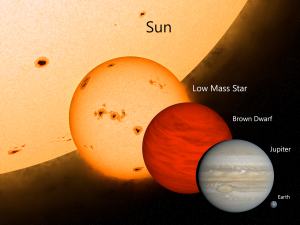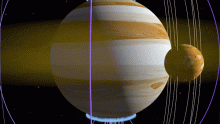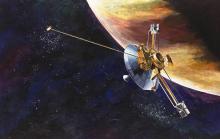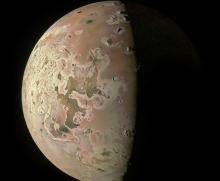Jupiter, the largest planet in the solar system, is a popular size. Many heavier planets in other star systems are about the same size, as are most brown dwarfs (objects that are more massive than planets but not massive enough to shine as true stars) and the lowest-mass stars, known as red dwarfs. The size is dictated by the object's mass and processes in its interior. As an object gets heavier, gravity squeezes it more tightly, making it hotter; radiation pressure pushes outward, keeping the size tightly controlled. The Sun and Earth are shown for comparison. [Planetkid32/Wikipedia]
You are here
Moon and Jupiter
The Moon and the planet Jupiter will be quite chummy the next couple of mornings. Jupiter will stand close to the Moon at dawn tomorrow, and a little farther on Wednesday.
Jupiter looks like a brilliant star. But it’s really a planet -- the solar system’s largest -- about 11 times wider than Earth.
That’s a popular size for objects throughout the galaxy, including planets, brown dwarfs, and even stars -- objects that can be many times heavier than Jupiter.
Jupiter and many of the planets in other star systems are big balls of gas with solid or semi-solid cores. Because they’re so heavy, gravity squeezes them tightly. But it can squeeze only so much. The gases and solids reach a point where they can’t be squeezed any tighter. That point depends on the mass of the planet -- a heavier planet has stronger gravity, so it can squeeze itself to a higher density. The balance point is at about the size of Jupiter.
The same thing happens with brown dwarfs -- objects that are more massive than planets, but not massive enough to shine as stars. They’re held up in part by heat from their cores, which pushes outward against the surrounding gas.
And something similar happens with lightweight stars. Gravity is balanced by the radiation from nuclear reactions in the star’s core. So a star that’s up to a couple of hundred times Jupiter’s mass isn’t much bigger -- a one-size-fits-all pattern for heavy planets and lightweight stars.
Script by Damond Benningfield
Get Premium Audio
Listen to today's episode of StarDate on the web the same day it airs in high-quality streaming audio without any extra ads or announcements. Choose a $8 one-month pass, or listen every day for a year for just $30.






